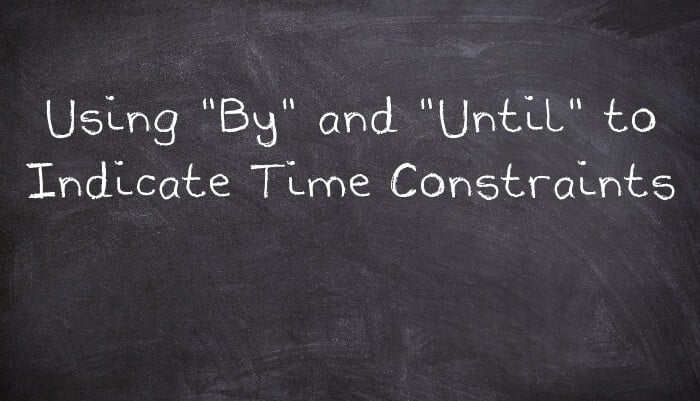The English language provides us with various tools to express time constraints, two of which are "by" and "until." These expressions play a crucial role in clarifying when an action should be completed or how long it should last. In this article, we will delve into the proper usage of "by" and "until" and explore their different nuances.
"By": Setting a Time Limit for Completion
The preposition "by" is commonly used to establish a deadline or time limit by which an action or task should be accomplished. Consider the following examples:
- "It must be ready by Friday."
- "The project report should be submitted by the end of the month."
In these sentences, "by" implies a sense of urgency and emphasises that the action needs to be completed no later than the specified time. It indicates a specific deadline and carries the expectation that the task should be finished on or before that deadline. Note that "by" functions as a preposition in these instances.
More Examples
-
"Please submit your report by 5 p.m. tomorrow." (implies that the report should be submitted anytime before 5 p.m., but not after)
-
"You must arrive at the airport by 8 a.m. to catch the early flight." (implies that you need to be at the airport before 8 a.m. in order to catch the early flight)
-
"I need the project proposal by the end of the week." (implies that the project proposal should be delivered before the week is over)
-
"Complete the online registration by Friday afternoon." (implies that the online registration needs to be finished before Friday afternoon)
-
"Please RSVP by Monday so we can finalize the guest list." (implies that your response is required before Monday for the purpose of finalizing the guest list)
"Until": Duration of an Activity Leading to a Time Limit
We use until when an activity continues throughout the period up to the time limit. It denotes the duration within which the action persists. Consider the following examples, where "until" serves either as a preposition or a conjunction. As a preposition, it specifies the time limit during which the activity occurs. As a conjunction, it connects the duration of the activity with the moment of completion.
When used as a preposition, "until" indicates the time until which the activity will continue. For example:
- "I'll be here until five o'clock."
This sentence implies that the speaker will remain present until the clock strikes five. The activity of being present extends up to that particular time and then concludes.
Alternatively, when "until" functions as a conjunction, it connects the duration of the activity with its completion. For instance:
- "Please keep working until you finish the task."
In this case, "until" conveys the idea that the activity of working should persist continuously until the task is fully completed.
More Examples
-
"You can work on your assignment until 6 p.m., but it must be submitted by then." (implies that you have the duration leading up to 6 p.m. to work on the assignment, but it must be submitted before that time)
-
"The sale is valid until the end of the month, so make sure to take advantage of the discounts before then." (implies that the sale will last until the end of the month, indicating the duration during which you can avail the discounts)
-
"You have until tomorrow morning to provide your feedback on the proposal." (implies that you have the duration leading up to tomorrow morning to provide your feedback)
-
"The tickets are available until the concert starts, so make sure to purchase them before then." (implies that the tickets will be available for purchase until the start of the concert)
-
"The special offer is valid until the store closes tonight." (implies that the special offer will be available until the store closes tonight, indicating the duration during which you can take advantage of the offer)
Summary
Understanding the distinctions between "by" and "until" is essential for effectively communicating time constraints in English.
While "by" designates a specific deadline or time limit by which an action should be completed, "until" emphasises the duration leading up to a particular time or the continuous nature of an activity until its completion. By employing these expressions accurately, you can convey precise temporal information and enhance your communication skills in both spoken and written English.
